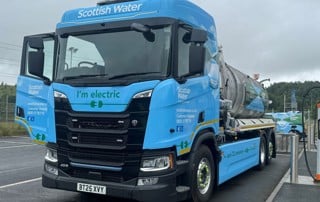A Government consultation on changing the rules governing electric vans is predicted to pave the way for greater uptake by fleets, but concerns over charging infrastructure remain.
Logistics UK believes the consultation, which runs until March 3, provides the opportunity to deliver regulatory alignment between 4.25 tonne electric vans and 3.5 tonne diesel vans.
Fleet News has previously reported how fleets were cancelling orders for 4.25-tonne electric vans, because of ongoing confusion over regulations surrounding their use.
Logistics UK head of infrastructure and planning policy, Jonathan Walker, said: “The current situation, where 4.25 tonne electric vans are treated as HGVs in terms of MOT and driver hours requirements, is nonsensical and is limiting the adoption of cleaner electric vehicles.
“The vehicles are the same size and used to perform the same tasks as traditional vans: it is only the extra weight from the batteries which moves them into a heavier weight category.
“From an operational point of view, the vehicles are the same and aligning regulations will make it easier to integrate electric vehicles into fleets.”
Among the changes being considered is a proposal to transfer the annual testing of zero emission goods vehicles (ZEGVs), with a GVW of 3.5t to 4.25t, from the heavy vehicle testing system to the MOT network, with the tests used for 3t to 3.5t goods vehicles put in place.
It would also amend annual testing schedules for ZEGVs, with a MAM of 3.5t to 4.25t, so their first test is after three years from first registration (and annually thereafter).
Furthermore, the Department for Transport (DfT) suggests the removal of electric vehicles (EVs) with a MAM of 3.5t to 4.25t (and when used with a trailer in a combination with a MAM up to 7t) from the requirements for tachograph use, the assimilated drivers’ hours rules (Regulation (EC) 561/2006, as it has effect in the UK) and specific road transport working time rules when used within Great Britain (GB).
Walker said: “Removing the requirement for tachographs and drivers’ hours restrictions that are intended for HGVs means there would be no disruption to shift patterns.
“In addition, annual roadworthiness checks could be carried out in the comprehensive MOT network instead of the heavy vehicle testing system.”
He continued: “We have long been campaigning for full regulatory alignment between 4.25 tonne electric vans and 3.5 tonne diesel vans, and this consultation is a clear indication that the Government is listening to the sector’s concerns.
“Alongside its main proposals, we continue to press the Government to remove the requirement for five hours additional training to drive an electric van and lift the prohibition on the towing of a trailer.
“Vans are the workhorses of the UK economy and all barriers to their use need to be removed so drivers can use a zero-emission van just as easily as a petrol or diesel equivalent.”
Lack of charging infrastructure a ‘major blockage’
The Road Haulage Association (RHA), meanwhile, says that a lack of charging infrastructure is a major blockage preventing the rapid introduction of electric vans and trucks, with the problem being particularly acute for commercial vehicle operators.
It is calling for local authorities and the energy companies to ensure infrastructure for vans, lorries and coaches is urgently prioritised.
With new battery electric van registration volumes rising by 3.3% to 22,155 units last year, equating to a 6.3% market share – the same as in 2023 but short of the Government target of 10%, the RHA says that practical measures are needed to ensure vans can access the public car EV network; for example, removing height barriers so that vans can access dedicated charge points in car parks.
When 8,200 charge points at 3,000 locations are needed for lorries by 2030, the RHA added that having just one public HGV charging point at the M61 Rimmington Services is not good enough.
Urgent action is needed to speed up both planning applications for HGV and coach recharging hubs and connections to the National Grid, it said.
























Login to comment
Comments
No comments have been made yet.